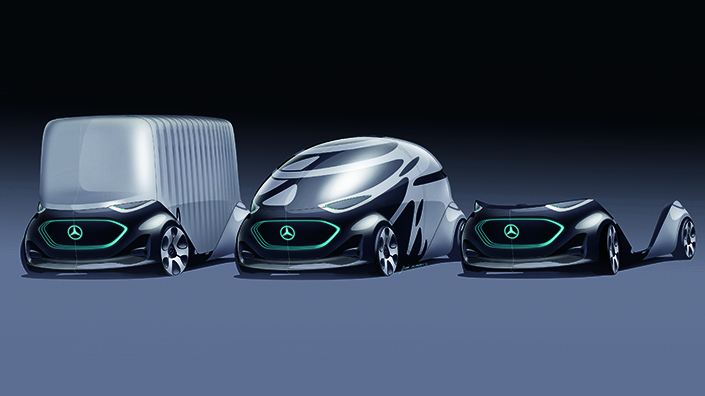Engineering news
The Vision Urbanetic is, says the carmaker, a “completely new mobility concept”. The chassis is a 5m-long, electric, autonomous ‘skateboard’. A modular body is placed on top – a passenger pod that can carry 12 people or a cargo module. And an artificially intelligent system links the fleet, monitors demand and sends the vehicles where needed.
The passenger and cargo pods could be switched-over automatically or manually in “just a few minutes,” Mercedes claims, efficiently meeting demand to reduce traffic. The concept is an ambitious vision of a potential transport system. It is also very weird.
Traffic ahead
“It’s obviously high concept,” says Dan Sturges, futurist and professor of transportation design at the College for Creative Studies in Detroit, Michigan. He focuses on the design of the pods – the one for passengers with a “wild” window pattern, and the squared-off cargo container capable of holding 10 pallets or smaller deliveries.
One mundane aspect shows that the concept is meant for a point far in the future, says Sturges – fitting 12 people in the passenger pod would only be possible without pesky, space-filling seatbelts, requiring a currently non-existent level of autonomous safety and trust in technology.
“I’d probably rather ride in the boxy one,” he says. “I’m getting a little tired of companies showing concepts carrying people and they try to fit as many as possible. I’d rather have more space.”

The Vision Urbanetic in its three stages – cargo, passenger and just the base (Credit: Daimler)
The pod-swapping system could work, Sturges says, and the ‘skateboard’ platform reminds him of a 2002 General Motors design. The “intelligent, self-learning IT infrastructure” could also work, he says, and would benefit from the relationship between Mercedes and transport network company VIA Transportation.
The network would evaluate local information to meet demand, Mercedes says, such as sending passenger pods to a venue when a concert ends. The result, the manufacturer claims, would be a system with “fewer vehicles on a virtually unchanged roads infrastructure… flexible and comfortable movement of people, efficient and sustainable transportation of goods, lower noise and emissions, and greater freedom in city planning”.
Switching issues
It all sounds so simple, but the concept presents real engineering challenges. The announcement glosses over the automated process for switching pods, for instance. Quickly changing large modules will require mechanical innovation, and ensuring safe connections between parts would be paramount. But the biggest challenge might be convincing people to get in it.
Content published by Professional Engineering does not necessarily represent the views of the Institution of Mechanical Engineers.